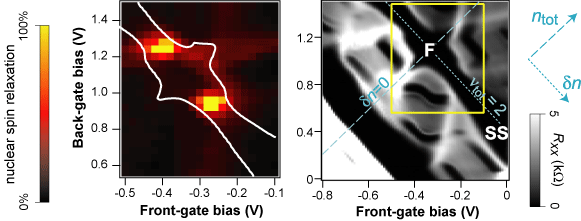|
Spin dynamics in a bilayer nu=2 quantum Hall system
In a bilayer quantum Hall system at total Landau level filling factor nu=2, various magnetic phases are caused by the interplay of ferromagnetic intralayer correlations and antiferromagnetic interlayer correlations.
When the two layers are well separated, the system is the ferromagnetic phase.
As the interlayer interactions becomes strong, the system transits to the spin-singlet phase via the canted antiferromangetic (CAF) phase. |
| Unfrozen Fluctuations | from "this week in Science: 21 July 2006" |
|
In conventional ferromagnets or antiferromagnets, strong crystal fields tend to pin the magnetization to a particular crystallographic direction. In contrast, quantum Hall systems based on high-mobility two-dimensional electron systems (2DESs) are free from such unwanted perturbations and offer an ideal opportunity for experimentally investigating low-energy physics in two dimensions. Kumada et al. (p. 329) used a bilayer system of two closely separated 2DESs to look at the spontaneous ordering of the spins. Low-frequency electron-spin fluctuations did not freeze out even in the limit of zero temperature, a hallmark of canted antiferromagnetic order in two dimensions.  (left panel) Degree of nuclear spin relaxation. Between the ferromagnetic and spin-singlet phases, exactly where the canted antiferromagnetic phase is expected to occur, two bright spots for fast nuclear spin relaxation appear. This shows in-plane antiferromagnetic order accompanied by low-frequency spin fluctuations. (right panel) Magneto-resistance of the bilayer quantum Hall system. Blue dotted and dashed lines indicate the constant filling factor of nu=2 and the balanced bilayer system, respectively. |